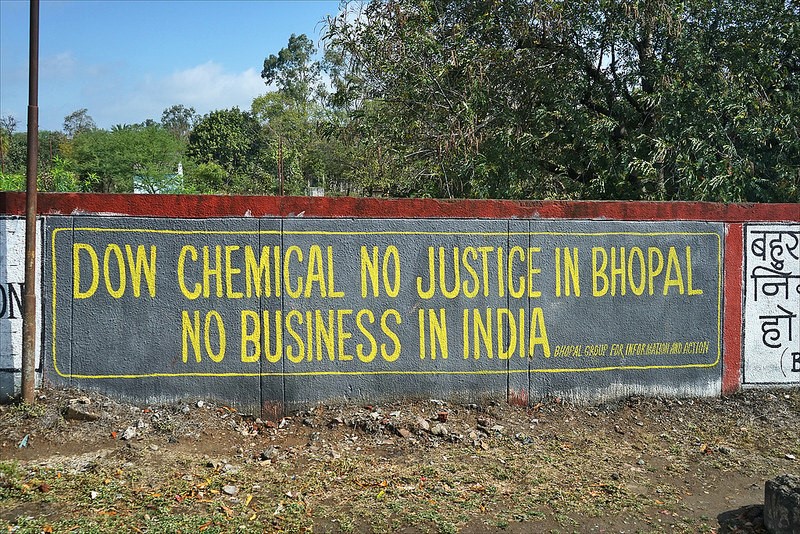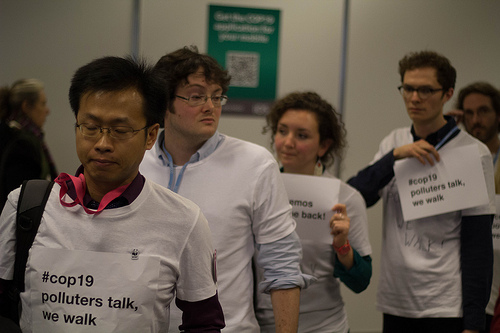Don’t Bury Bhopal: a community seeks justice
It’s one of the most horrific, haunting photographs of all time, and I’ve been thinking about it a lot lately.
It’s the image of a partially buried, tiny child, her ashen face surrounded by stony soil as her dead eyes stare skywards and her father’s hand takes one last, tender touch.
It was taken by Magnum photographer Raghu Rai on the morning of 4 December 1984, the day after the Bhopal disaster, when the Union Carbide factory leaked almost 30 tons of the deadly methyl isocyanate gas across the Indian city, instantly killing thousands of innocent people in the world’s worst industrial disaster. The little girl in the photo was just one of the victims – and hundreds of thousands of people living in Bhopal right now are still suffering today as a result.
The photo has been in my mind almost constantly since last week, when the $130 billion merger of US chemical giants Dow Chemical and DuPont was confirmed to form DowDuPont, one of the biggest mergers in corporate history which has created the world’s biggest chemical company.
Why? Because DowDuPont was responsible for the death of that little girl, and for almost 33 years of unimaginable misery suffered by the people of Bhopal ever since.
More than half a million people were exposed to the gas with at least 3,800 killed immediately and more than 25,000 have died since as a result of their exposure. More than 150,000 people still suffer from ailments such as blindness, extreme difficulty breathing, kidney and liver failure and gynaecological disorders caused by the accident. Some 50,000 can’t work because of disaster-related conditions.
Cancer rates in the city have rocketed since and children right now are being born dead, or mentally or physically disabled in numbers not seen since the spate of births that followed the gas catastrophe.
The vast majority of these victims live in squalor and poverty.
How are DowDuPont responsible? Dow Chemical took over Union Carbide in 2001 – taking on all its assets and liabilities – and it’s now part of the DowDuPont behemoth.
Union Carbide never properly cleaned up after the disaster. On top of that, in the 15 years before the gas disaster, Union Carbide routinely dumped highly toxic chemical waste in and around its site. After the catastrophic gas leak, the factory was simply locked up and left to rot, with all the toxic waste still there. These toxins have leaked into the drinking water supplies of the poor people of Bhopal.
Dow Chemical – now DowDuPont – has steadfastly refused to clean up the site ever since, let alone provide safe drinking water or compensate the victims properly.
It wasn’t until 1989 that Union Carbide, in a partial settlement with the Indian government, agreed to pay out some $470 million in compensation. That worked out at a disgusting $300-$500 each person, or just five years’ worth of medical expenses. But there has been no compensation at all for people who have become victims of the Bhopal disaster since the gas leak because of the contaminated water.
Survivors have fought to have the area cleaned up, but their efforts were stymied by the Dow Chemical takeover of Union Carbide, and now by the latest Dow DuPont merger. The victims of Bhopal have been left to fend for themselves as Dow DuPont continues to ignore their plight, refuses to fulfil its legal and moral obligations or pay a penny to help. Along with the charity The Bhopal Medical Appeal, I believe it to be a disgrace that Dow DuPont is continuing to stonewall the victims.
Until the newly-merged company finally accepts responsibility, The Bhopal Medical Appeal will continue to run its two clinics in the city, offering free medical treatment, rehabilitation and social support to both victims of the gas disaster and the ongoing water contamination. The victims have nowhere else to turn.
What else can be done? Creative agency Soul London are running a campaign to get DowDuPont to finally accept responsibility for the continuing misery Bhopal people are enduring, and to prevent the Bhopal disaster from being buried in the merger.
We came up with a new campaign for The Bhopal Medical Appeal, which uses a simple animated film to combine the corporate logos of Dow Chemical and DuPont. As the two logos merge together to form a new logo that spells the word “DoNT” – Don’t let this merger bury the world’s worst chemical disaster. We want people to keep sharing the animation as much as possible on social media with the hashtag Don’t Bury Bhopal pressurise DowDuPont.
New generations of Bhopalis are sick and dying. If enough people raise their voices together, DowDuPont will no longer be able to ignore their suffering.
Please share the animation and Tweet – #DontBuryBhopal



Thank you Shaun Moran, you are quite right, we need voices and we can’t let this company evade its responsibilities. As the campaign says #DontBuryBhopl
Dear moderator. I need to edit the above comment…. the hashtag should read : #DontBuryBhopal